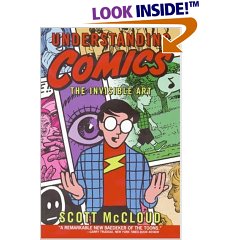Scott McCloud Calls Them “Comics” (Sequential Art)
 In Understanding Comics: The Invisible Art Scott McCloud never really commented on the term graphic novel—which I feel is cool. But that is trivial compared to the eye-opening revelations waiting for me:
In Understanding Comics: The Invisible Art Scott McCloud never really commented on the term graphic novel—which I feel is cool. But that is trivial compared to the eye-opening revelations waiting for me:
- Most importantly is the concept of closure. From webcomicsreview.com: “Closure— 1) The human tendency to perceive a ‘whole’ from incomplete parts. 2) The human tendency to unconsciously fill in gaps in sequences and patterns. In comics, closure is often used to create the illusion of time and motion. According to McCloud, closure forms the ‘grammar’ of comics.”
- Second is iconography. From webcomicsreview.com: “Icon—A visual, frequently pictorial representation of a thing or idea. Generally, the more broadly applicable or widely recognized an icon, the more ‘iconic’ it is considered to be. (For instance, a happy face is more iconic a realistic portrait of a particular person.) According to McCloud, visual iconography forms the ‘vocabulary’ of comics.”
- Third are the reasons for using graphic icons instead photorealistic representations of characters. McCloud argues that photorealism distances and objectifies while icons allow the reader to see themselves in the character forms.
 For me, the closure thing is what has held my interest for years. Closure can be poetic so my attraction to it is obvious. Now, the icon stuff is more about art class and drawing lessons (which can be fun)—in the European context. However, thank the Lord—all my soul—when my eye looks upon what is called “African Art,” we see this concept of “iconography” all over the place! Inviting Mr. McCloud into my little, post-modern African hut means that (again) we “discover” how advanced African visualization can be with its three-dimensional iconography carved in “primitive” wood. When the wood carver is finished you may see yourself in the tree…
For me, the closure thing is what has held my interest for years. Closure can be poetic so my attraction to it is obvious. Now, the icon stuff is more about art class and drawing lessons (which can be fun)—in the European context. However, thank the Lord—all my soul—when my eye looks upon what is called “African Art,” we see this concept of “iconography” all over the place! Inviting Mr. McCloud into my little, post-modern African hut means that (again) we “discover” how advanced African visualization can be with its three-dimensional iconography carved in “primitive” wood. When the wood carver is finished you may see yourself in the tree…
It looks like Understanding Comics: The Invisible Art is the first of what eventually became a trilogy. The other two McCloud meta-comics (that I am aware of) are: “Reinventing Comics: How Imagination and Technology Are Revolutionizing an Art Form” and “Making Comics: Storytelling Secrets of Comics, Manga and Graphic Novels.” Hah! See “graphic novels” there?
I am so all over these books… and, hey, what about this guy, Will Eisner?
